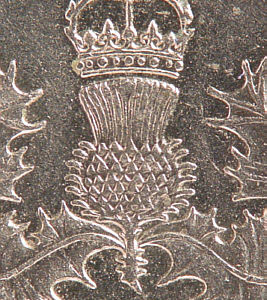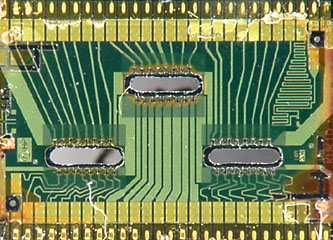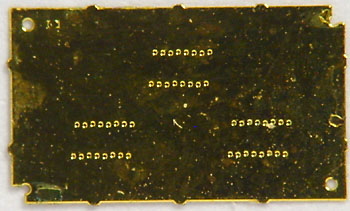Some consumer digicams have a lens or lens adaptor filter threads comparable in size to those of a 35 mm SLR lens. So the well known technique in film photomacrography of using a 'reversed' and 'stacked' lens is becoming widely adopted to extend these digicams' macro capabilities (see 'Links' below).
The author owns a Sony S-75 digicam which has a useful macro mode, but when needed, adding a reversed 50 mm SLR lens considerably extends the macro performance. I summarise the pros and cons of this set-up below, as owners of the other 'wide barrel lens' models e.g. by Sony, Canon and Olympus may be interested in trying the technique if unfamiliar with it.
Choosing a reversed lens
I suspect many digicam converts
like myself already own a range of 35 mm SLR gear (in my case its rapidly
gathering dust!). So there could be well be a lens in the 'SLR bag' that
will suit.
Photomacrography books (e.g. ref.
1) note that the best lenses for reversed use are those with a 'symmetrical'
optical design (see images below); many standard 35 mm SLR lenses conform
to this pattern. As the magnification at the image plane is a function
of fp / fr
(where fp is the focal
length of the prime lens and fr
that of the reversed lens), a smaller focal length lens like a wide angle
can achieve greater mags. These lenses are certainly worth trying but are
less likely to be of a symmetrical design and may cause problems.
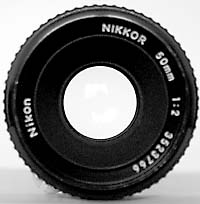 |
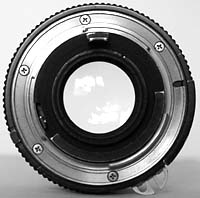 |
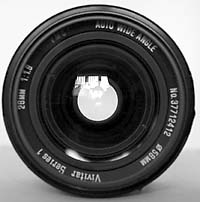 |
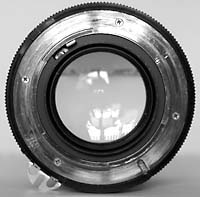 |
| Nikkor 50 mm f2 lens,
front and rear view (first two images from the left). The iris size is
similar for both views indicating a 'symmetrical' lens design and thus
is suitable for reversed lens work (ref. 1).
Vivitar Series 1 28 mm f1.9 lens (the two right-hand images). Although a higher f number lens, front and rear views show the marked size difference of the iris indicating a non-symmetrical design. It proved to be unsuitable when reversed on the S-75 as it gave gross vignetting and barrel distortion. |
|||
Attaching the lens
This is straightforward if the threads
match exactly, a 52 mm to 52 mm coupling ring is all that is required for
the Sony S-75 lens adaptor and Nikkor 50 mm f2 standard lens. These coupling
rings are sold in a range of sizes (55-55 mm etc). They can be used with
filter 'step-up' and 'step-down' rings to match slightly dissimilar thread
sizes.
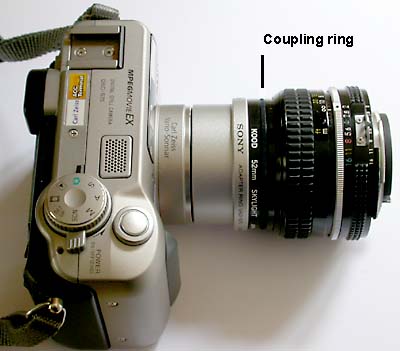 |
| The Sony lens adaptor (VAD-S70) is a sturdy metal unit (silver collar in the image) which screws into the metal camera body, protecting and extending beyond the external focussing Carl Zeiss 3X zoom lens. So there's little danger of stressing the camera, adaptor or lens thread if the combination is used carefully and supported properly. (The UV/skylight filter can be left on as shown here, if desired.) |
The Nikkor 50 mm f2 lens in use
The recommended settings for 35
mm work with a reversed lens were adopted, i.e. the standard lens set on
infinity with its iris wide open. The digicam was set on max zoom and infinity.
Ideally the digicam should be stopped down as far as practical for max.
depth of field. This sort of set-up has a fixed focus distance so I prefer
to set the camera-subject distance manually rather than using the often
wayward 'focus hunting' of digicams at close focus on low contrast subjects.
I carry a stiff piece of card with a length of the required distance to set focus, but there's no reason why a metal frame can't be attached to the lens front to frame the subject at this distance.
Assessing performance
When first assessing and comparing
macro set-ups it's useful to photograph graph paper. The images will provide
an immediate indication of field of view, field flatness, light fall off
and any lens aberrations such as barrel distortion can be assessed. (To
make the results meaningful, a rigid desktop set-up is best to ensure no
camera shake and accurate alignment of camera and paper. The small spirit
level 'cubes' are useful to check alignment).
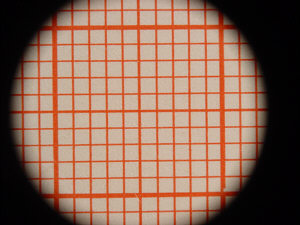 |
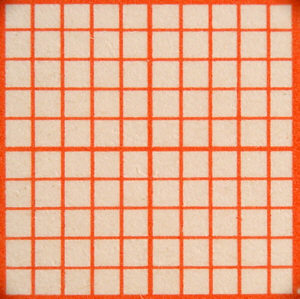 |
| Image left: Whole
camera field of view on Sony S-75 at max. zoom with reversed Nikkor 50
mm f2. 1 mm squares.
Image right (reduced from master): When cropped a ca. 9 mm x 9 mm field of view is possible. There's very little barrel distortion and good field flatness. | |
The macro performance of the S-75 is considerably extended with this set-up. A usable cropped field of view of 9 x 9 mm is available compared with ca. 4 x 3 cm for closest macro for the S-75 alone.
Stacking a reversed standard lens
is based on sound optical principles and this is indicated by the flat
and undistorted field (better in fact than the S-75 at closest macro where
slight barrel distortion is evident). Reversing a lens on a 35 mm zoom
lens is not usually recommended; a medium telephoto 100 - 200 mm is usually
suggested. However, the image doesnt seem to suffer unduly with the extra
glass in a digicam's zoom lens.
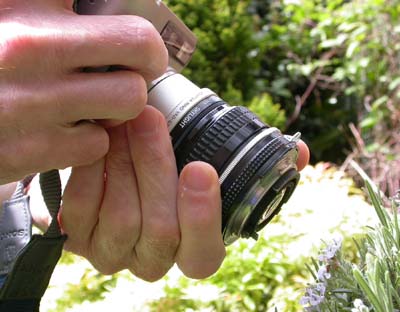 |
| The lens extension allows a good
firm hold for outdoor work. The camera is shown at its working distance
(from the small purple flower) of 3.8 cm which is relatively high for this
sort of macro and allows natural light use. The internal flash may be restricted
by the extended lens but an external synched flash can be tried.
The 'front' lens element is vulnerable, but the technique is so widely established for 35 mm work that bayonet mount lens hoods are available if desired to keep fingers away. Indoors the unit can be mounted on a copying stand. The author uses it on a tripod over desk; the geared height adjustment on the tripod acting to set the focus distance. |
The vignetting for this sort of set-up is not necessarily a disadvantage with the high resolution digicams available nowadays, as extreme macro is often of small centrally placed subjects. The S-75 has a fairly modest (by today's standards) 3 megapixel resolution but provides a square 1100x1100 pixel image after the vignetting is cropped, which is a size more than sufficient for e.g. web use.
The extent of vignetting is dependent on the f number of the standard lens (in this case f2). An f1.8 or even f1.4 should be better in this respect. Cameras with a larger zoom range e.g. the 5X on the 'Sony F' range may also reduce the vignetting.
Merits of a reversed standard
lens cf close-up lens sets on an S-75
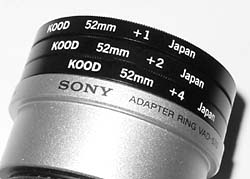 Another
way of extending the macro using odds and ends from the 'SLR bag' is by
using the single element close-up lenses commonly supplied as +1, +2, +4
diopters. Although they are much more practical to use and cause little
to no vignetting, the macro is only significantly extended when the three
close-up lenses are 'stacked' (shown right) but then image quality can
nosedive with the uncorrected cheap lenses. So I prefer the more 'powerful'
reversed 50 mm lens.
Another
way of extending the macro using odds and ends from the 'SLR bag' is by
using the single element close-up lenses commonly supplied as +1, +2, +4
diopters. Although they are much more practical to use and cause little
to no vignetting, the macro is only significantly extended when the three
close-up lenses are 'stacked' (shown right) but then image quality can
nosedive with the uncorrected cheap lenses. So I prefer the more 'powerful'
reversed 50 mm lens.
For other users (and camera models) the practicality of close-up lenses may be preferred. One approach to assess them is to buy a cheap close-up lens set to see if they are useful (check the local camera shop's junk bin), and if a given diopter combination proves valuable, a high quality lens of that diopter value can be bought. The cheap ones are uncorrected and uncoated but higher quality achromatic doublets are available and have been widely assessed for digicam use (see 'Links' below).
